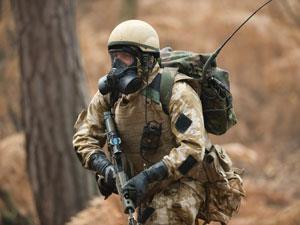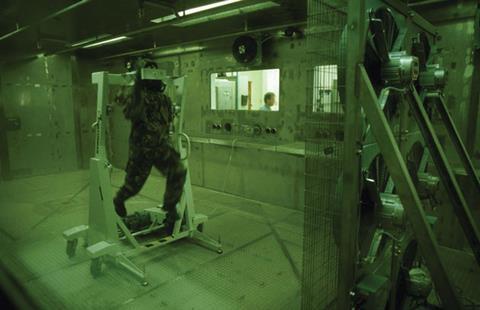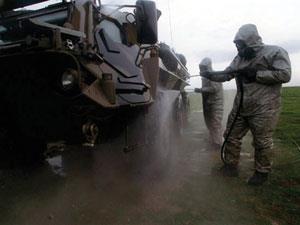The UK’s Defence Science and Technology Laboratory has a near century-long history of working with chemical weapons. Philip Robinson reports from Porton Down
In a sunlit atrium, suited men and women sit at scattered tables, consult documents and laptops, and queue for coffee. An unremarkable scene found in research institutions all over the world.

But a second glance highlights the impressive adherence to security protocol. Further glances take in posters of fighter jets and the occasional figure in camouflage. Realisation dawns as the occupants of a nearby room bustle out, several of them in uniforms decorated with the ribbons of military service. This is no ordinary research institute. It is the Defence Science and Technology Laboratory (DSTL) at Porton Down, the UK’s scientific research facility for the armed forces.
‘The role of DSTL is to maximise the impact of science and technology for the defence and security of the UK,’ explains Andy Bell, DSTL’s chief technical officer. DSTL has four main sites working on a huge range of military and security issues. The chemists in the Chemical and Biological Radiological (CBR) area at Porton Down are focused on protecting military personnel and, increasingly, civilians deployed alongside them from the threats of chemical weapons.
Porton Down has a long history of dealing with these chemicals. In October 1915, at Ypres in Belgium, thousands of French troops fell in minutes as a cloud of chlorine gas submerged their trenches, beginning a new era of chemical warfare. In 1916, Porton Down was selected to host the UK’s response, developing chemical capability and countermeasures for the military.
Investigations into use

Conducting investigations into suspected chemical weapon use globally is one of their roles. ‘We have a very strong analytical chemistry capability. It is world-renowned,’ says Andy. The techniques used are laboratory stalwarts such as mass spectrometry and NMR. But the team’s expertise can reveal much more than the presence or absence of a particular agent. ‘You can see chemicals that are left over from production and the impurities can tell you how sophisticated that agent is; you can tell if it has been stabilised, so if it’s being stored,’ explains DSTL chemistry fellow Chris Timperley. ‘We can tell if a site’s been decontaminated – decontaminants leave their own signatures – or even burned.’
In 2013, the lab was one of several to receive samples from Damascus in Syria, which tested positive for the nerve agent sarin. They also provided expertise following the Moscow theatre siege in 2002, when Russian special forces stormed a theatre to liberate hostages held by Chechen terrorists. Before entering, the Russian forces incapacitated the assailants by flooding the theatre with an aerosol – killing over 120 hostages. Samples of clothing and urine taken from the victims analysed at Porton Down revealed a mixture of remifentanil and carfentanil. The latter is a sedative only approved for use in animals.
Model predictions
Porton Down’s 7000 acre range once saw large-scale tests to study how agents disperse into the atmosphere. Today those trials are conducted virtually, on fields of silicon. ‘We use models to predict the downwind hazard and the concentrations of a material,’ says computer modeller Chris Hindmarsh. ‘Typically, that chemical would be reacting as it disperses, so we have to look at the atmospheric chemistry too.’
‘Simulant’ materials that closely approximate the physical or chemical properties of their highly toxic counterparts are used to inform the models. ‘We’re not going to use very dangerous chemicals to look at validating dispersion models, so we take simulants that have similar properties,’ he says.
These complex models are used to provide real-time support to commanders in the field making decisions about hazard containment and evacuation.
Porton Man
In collaboration with academia, Porton Down chemists are also working to improve the protective equipment used by the military. Current respirators, for example, use carbon filters but metal–organic frameworks are being investigated as promising candidates for lighter, more effective filters. Efforts to improve liquid repellency of materials are also ongoing. ‘Superhydrophobicity is relatively easy to achieve because water has such a high surface energy. But the surface energies of liquid chemical warfare agents are a lot lower,’ explains materials scientist Colin Willis. ‘We took some chemistry developed at the University of Zurich, growing poly(methylsiloxane) nanofibres onto textiles and then using a plasma polymerisation coating technique, to produce a material that displays super repellency towards liquid chemical warfare agents.’
Protective clothing has got to be cheap and it's got to be robust
But on the battlefield, sophistication must again take a back seat to reliability and durability. ‘It’s got to be cheap [and] it’s got to be robust,’ says Colin. Assessing robustness falls to Porton Man. This mechanical mannequin suits up to help Colin’s team see how well their materials perform on the body. But this version is soon to start a well-earned retirement. ‘We’ve been working with i-bodi Technology who did a lot of work on [BBC TV series] Walking with dinosaurs. We’ve produced a next-generation mannequin with real-time dosimeters, based on miniature ion mobility spectrometers, so we can measure in real time how a suit is performing. We can see where the weak spots are and that will help us develop better suits.’

You may even find yourself wearing some protective technology developed at Porton Down. Much of the DSTL’s technology can be turned to civilian and commercial applications. In 2004, a plasma polymerisation technology was spun out to form the company P2i, which works with textile and electronics manufacturers to provide water-repellent finishes (see http://rsc.li/TM0412). ‘That’s one of our big success stories,’ says Colin. ‘I believe P2i now have a mobile phone that can operate under a metre of water for six hours.’
Cleaning up

Decontamination expertise for occasions where personnel do come into contact with hazardous materials is another task that falls upon Porton Down’s chemists. ‘Given the wide spectrum of potential contaminants that we may need to decontaminate – radiological, chemical and biological – and the range of surface types from skin to sensitive electronic equipment, it’s a huge problem space,’ says Norman Govan, an expert on decontamination processes.
That demands a broad-spectrum approach and again ease of use is a priority. ‘The current in-service personal decontaminant for chemicals is Fuller’s earth,’ says Norman. Clay may be low-tech, but Norman’s team are currently working with academic research groups to employ cutting-edge chemistry in decontamination.
‘Our research is trying to develop technologies with the potential to remove personnel from the process altogether. Key to this is the development of materials that can trigger a favourable molecular event, such as a colour change to disclose the location of contamination, or a release of decontaminant from microcapsules held in a self-decontaminating coating’ says Norman.
Another aspect of his team’s work is developing formulations to deliver a decontaminant to a surface more effectively. ‘We have recently developed microemulsion-based decontaminants that can be tuned, at point of use, to achieve optimal decontamination of military equipment,’ he says.
A positive legacy
DSTL chemists also work closely with the Organisation for the Prohibition of Chemical Weapons. The OPCW coordinates the destruction of chemical weapons stockpiles globally and received the 2013 Nobel peace prize for its efforts. As vice-chair of the OPCW scientific advisory board, Chris T was among the team that received the award, along with another DSTL employee, Robin Black. But Chris T insists that the recognition belongs to a much larger group. ‘The prize recognised an enormous effort by diplomats over years, the scientists that have given advice and it also pays tribute to those that lost their lives. It’s a tremendous honour and privilege to be part of that,’ he says.
DSTL also works to eliminate stockpiles of chemical weapons globally, through its non-proliferation activities. As chemical weapons are steadily destroyed, vigilance, awareness and education are needed to safeguard the future, says Chris T. ‘There are so many good applications in chemistry, but there’s also a negative side and one of them is chemical weapons. The message now is to reach out and educate people because the next generation are the ones that will inherit all the work we’ve done.’
Philip Robinson is careers and comment editor for Chemistry World
Reaching out to the next generation
The nature of DSTL’s work means that security and safety concerns prevent school-aged children coming onto any of their four sites to see what they do. Instead, DSTL encourages its scientists and engineers to become STEM ambassadors. This scheme – coordinated by STEMNET (the Science, Technology, Engineering and Mathematics Network) – supports the teaching of STEM in schools. ‘I would estimate that we have at least two STEM ambassadors going out to schools each week,’ says Jaime Williamson DSTL’s STEM outreach manager.
‘The STEM ambassadors design activities to suit the school’s requirements,’ she explains. In primary schools it tends to be interactive demonstrations, for example DSTL chemists may use paper chromatography to show how they detect chemicals. For older children it tends to be more careers focused. This often takes the form of a presentation. ‘Some of our work can be difficult to demonstrate but we do try to do hands on stuff wherever we can.’ Schools also really value chemists coming in and explaining to the students the routes they have taken to get to a career in chemistry, says Jaime. ‘That would include talking about the decisions they made at GCSE, what they did at A-level, what modules they took through university, the work experience they gained.’ Schools are also currently keen on speed networking, she adds. Here a handful of STEM ambassadors are quizzed about what their jobs entail, what’s good about it, what’s bad about it, and the practicalities, such as starting salary, working hours, holiday allowance and other employee benefits.
Talent of tomorrow

DSTL has much to offer budding chemists just starting out on their career path. The company is a member of the newly formed 5% Club. This is a group of companies who have pledged that 5% of their UK workforce over the next five years will be young people on structured training schemes.
Students looking to work for a year before starting university can come to DSTL through the Year in Industry scheme coordinated by the STEM enrichment charity EDT. DSTL offers these year long, paid placements across the breath of its science and engineering interests, explains DSTL’s early careers advisor Kat Ward.
Once at university, DSTL has opportunities for students to carry out 8–12 week paid summer placements. ‘These students will provide practical support for projects we have ongoing here,’ says Kat. Meanwhile, students enrolled on ‘sandwich’ degree courses can apply to spend the third year of their degree working at DSTL.
Students who come to DSTL for any of these placements may be selected for sponsorship to support the remainder of their studies. Sponsored students are required to return to DSTL each summer during their degree. When they graduate – if they wish to apply to work at DSTL – they will be guaranteed an interview. ‘At the moment we have 51 sponsored students on our books,’ says Kat. ‘We have nine chemists due to join us, staggered over the next couple of years.’
DSTL has just recruited 80 graduates to start on its graduate development programme this September. ‘These are spread across all of our science disciplines,’ explains Kat. This two-year scheme give graduates a broad overview of DSTL’s remit as well as specific training to suit the department they are working within. ‘Throughout their two years on the graduate programme they are matched up with a mentor,’ she says. DSTL also offers funding possibilities for graduates wishing to stay on at university to study for a PhD.
For aspiring chemists who don’t feel university would suit them, DSTL is currently setting up a two-year LabTech apprenticeship programme. The laboratory technician apprenticeship will be tailored to meet DSTL’s specific needs. ‘It is a recognised apprenticeship, but the modules they take are immediately relevant to the work they will be doing in the lab,’ says Kat. ‘They can gather the evidence and the learning that they need on the job day-to-day, then build a portfolio over the two years to get their qualification.’









No comments yet